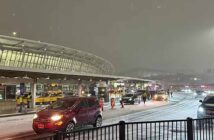
The tragic crash of Air India Flight 171, a Boeing 787-8 Dreamliner, on June 12, 2025, just 30 seconds after takeoff from Ahmedabad’s Sardar Vallabhbhai Patel International Airport, has prompted intense speculation about its causes.
The flight, bound for London Gatwick with 242 people onboard, plummeted into the Meghani Nagar neighborhood, killing 241 passengers and crew and at least 28 on the ground, with one survivor.
As India’s Aircraft Accident Investigation Bureau (AAIB), supported by the US National Transportation Safety Board (NTSB), investigates, several theories have emerged based on preliminary video footage, expert analyses, and eyewitness accounts.
- Improper Flap Configuration: The aircraft’s wing flaps appeared retracted during takeoff, a critical error as flaps are typically extended to increase lift and reduce stall speed at low altitudes This misconfiguration could have caused a catastrophic loss of lift, leading to the crash. Checklists and double verification ensure proper flap settings but flap settings did not look right, and potentially explain the aircraft’s inability to climb. Flaps retracted due to no hydraulic pressure is the lead theory as to cause of the crash in the immediate aftermath.
- Landing Gear Not Retracted: Video evidence indicates the landing gear remained extended, which is unusual as it is typically retracted post-takeoff to reduce drag and enhance aerodynamics. This could reflect a pilot’s attempt to manage a problem or insufficient time to retract due to the rapid sequence of events. Extended landing gear would have increased drag, hindering the plane’s ability to gain altitude. The failure to retract could also be due to no hydraulic pressure, the lead theory as to cause of the crash in the immediate aftermath.
- Dual Engine Failure: A rare dual engine failure, possibly due to bird strikes or fuel contamination., could have caused the crash. The theory of a bird strike causing engine failure has gained traction due to the crash’s occurrence during takeoff, a phase when birds are a known hazard near airports. A strike could incapacitate one or both engines, severely impairing the aircraft’s ability to climb. Ahmedabad’s urban setting increases the likelihood of bird activity. Bird strikes during takeoff, a critical phase, can disable engines, as seen in the 2009 US Airways Hudson River landing.
- Pilot Error: The rapid sequence of events—30 seconds from takeoff to crash—raises questions about pilot response. The flight was commanded by Captain Sumeet Sabharwal (8,200 hours of experience) and First Officer Clive Kundar (1,100 hours). The mayday call issued seconds after takeoff suggests the crew identified a problem, but no further communication followed. Pilots might have believed they could control the situation or return for landing, potentially misjudging the severity. Failure to follow checklists or respond to an anomaly could have contributed. The aircraft nearly overran the runway, which may have caused debris to go into the left engine and loss of thrust.
- Mechanical or Maintenance Issue: A compressor stall on the right hand engine during the takeoff has been speculated as the main contributing feature to the crash. Investigators will scrutinise Air India’s maintenance records, as airlines are responsible for aircraft upkeep. The 11-year-old 787, registered VT-ANB, had logged 41,000 flight hours and 8,000 cycles, average for its age, but any lapses in maintenance could have played a role. Robert A. Clifford, lead counsel in the Boeing 737 MAX crash litigation, said that video and eyewitness accounts suggest a loss of power or flight control, which may be tied to mechanical defects.
- Flight Control System Malfunction: The aircraft’s unusual behavior—reaching only 625 feet before descending with its nose up and wings level—suggests a possible flight control system issue. While footage showed no visible smoke or flames from the engines, a lack of engine power, possibly due to a computer programming issue, could explain the plane’s failure to climb.
- Computer Malfunction: A malfunction in the Boeing 787’s fly-by-wire system or a computer-related error could have disrupted critical controls, such as flap deployment or engine thrust settings. Comments about a potential “computer programming issue” with the engines aligns with this theory.
These theories, while informed by early evidence, remain speculative pending the AAIB’s findings. The recovery of one black box and ongoing analysis of the second will provide critical data on flight parameters and cockpit communications. The crash’s complexity, compounded by its urban impact site, demands a thorough investigation. Stabilising the wreckage site will delay answers. As the aviation community awaits clarity, these theories highlight the multifaceted challenges of ensuring safety in modern air travel




